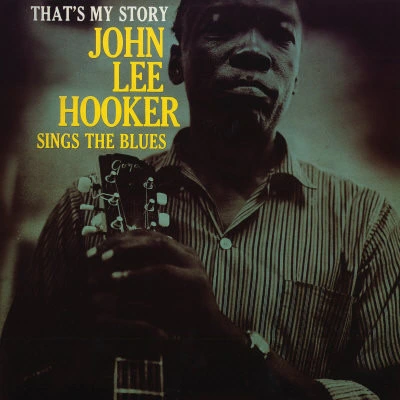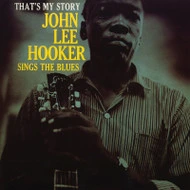Mastered by George Horn at Fantasy Studios & Pressed at RTI!
Features "Leave My Wife Alone" & More!
That's My Story was recorded in one session on February 9, 1960 at Reeves Sound Studio in New York City. It was produced by Orrin Keepnews and features the rhythm section from saxophonist Cannonball Adderley's group, which included bassist Sam Jones and drummer Louis Hayes.
The great country blues tradition that began with nameless wanderers, and first reached a wide public through the records of early singers like Blind Lemon Jefferson, has produced some of the most fundamental, nakedly emotional and deeply moving of all American music. So it should not be surprising that this music has always retained its power to hold and to stir listeners. Even through many years when the old blues seemed to have gone out of fashion, this great tradition would not die. And, as if to prove its immortality, there now appears to be a considerable resurgence: for one thing, the 'soul music' that is a direct spiritual descendant of country blues has become a dominant element in much of instrumental modern jazz; for another, a singer like Hooker can sing the honest blues the way he really feels them.
Much of the material Hooker sings and plays here is, of course, in the time-honored blues tradition: there are songs of fulfilled love ("I Want to Talk About You") and of departed lovers ("Wednesday Evenin'"), of harshly sardonic realism ("I Need Some Money") and of wistful longing ("I Believe I'll Go Back Home"). "Gonna Use My Rod" is a 'talking blues' in a familiar enough vein: the singer is warning his best friend to "leave my wife alone." Others, though, are more off the beaten path. "One of These Days" and "Come On And See About Me" are actually of gospel-song origin, although treated with a blues feeling; the latter is particularly effective in its merging of plaintiveness with a sharp note of impatience. "Democrat Man" is nothing less than social-political commentary, far more outspoken than blues of the old tradition would have dared to be, although topical material was often an important part of the early blues repertoire.
What it all adds up to is that John Lee is an individual: an emotion-stirring singer and powerful blues guitarist, firmly rooted in a great tradition, but very much a man of today. That's his tory, and it is surely also a way of making it clear that the blues are as new as they are old, and will probably always be that way.
The liner notes (in the fashion of the day) are almost apologetic... emphasizing that [the rhythm section is] not to create R&B rhythms, but to free Hooker from the burden of carrying the full rhythm load. To make matters more palatable for the purists, maybe thats why a couple of jazz players were chosen for the job (bassist Sam Jones and drummer Louis Hayes, who formed the rhythm section for Cannonball Adderley at the time). Whats important is not how pure the music is, but that its a decent album, striking a good midpoint between his acoustic and electric sound. All Music Guide
Features:
Vinyl LP
Mastered by George Horn at Fantasy Studios
Pressed at RTI
Musicians:
John Lee Hooker, guitar
Sam Jones, bass
Louis Hayes, drums
Selections:
Side 1:
1. I Need Some Money
2. Come On and See About Me
3. I'm Wanderin'
4. Democrat Man
5. I Want To Talk About You
6. Gonna Use My Rod
Side 2:
1. Wednesday Evenin' Blues
2. No More Doggin'
3. One of These Days
4. I Believe I'll Go Back Home
5. You're Leavin' Me, Baby
6. That's My Story
Features "Leave My Wife Alone" & More!
That's My Story was recorded in one session on February 9, 1960 at Reeves Sound Studio in New York City. It was produced by Orrin Keepnews and features the rhythm section from saxophonist Cannonball Adderley's group, which included bassist Sam Jones and drummer Louis Hayes.
The great country blues tradition that began with nameless wanderers, and first reached a wide public through the records of early singers like Blind Lemon Jefferson, has produced some of the most fundamental, nakedly emotional and deeply moving of all American music. So it should not be surprising that this music has always retained its power to hold and to stir listeners. Even through many years when the old blues seemed to have gone out of fashion, this great tradition would not die. And, as if to prove its immortality, there now appears to be a considerable resurgence: for one thing, the 'soul music' that is a direct spiritual descendant of country blues has become a dominant element in much of instrumental modern jazz; for another, a singer like Hooker can sing the honest blues the way he really feels them.
Much of the material Hooker sings and plays here is, of course, in the time-honored blues tradition: there are songs of fulfilled love ("I Want to Talk About You") and of departed lovers ("Wednesday Evenin'"), of harshly sardonic realism ("I Need Some Money") and of wistful longing ("I Believe I'll Go Back Home"). "Gonna Use My Rod" is a 'talking blues' in a familiar enough vein: the singer is warning his best friend to "leave my wife alone." Others, though, are more off the beaten path. "One of These Days" and "Come On And See About Me" are actually of gospel-song origin, although treated with a blues feeling; the latter is particularly effective in its merging of plaintiveness with a sharp note of impatience. "Democrat Man" is nothing less than social-political commentary, far more outspoken than blues of the old tradition would have dared to be, although topical material was often an important part of the early blues repertoire.
What it all adds up to is that John Lee is an individual: an emotion-stirring singer and powerful blues guitarist, firmly rooted in a great tradition, but very much a man of today. That's his tory, and it is surely also a way of making it clear that the blues are as new as they are old, and will probably always be that way.
The liner notes (in the fashion of the day) are almost apologetic... emphasizing that [the rhythm section is] not to create R&B rhythms, but to free Hooker from the burden of carrying the full rhythm load. To make matters more palatable for the purists, maybe thats why a couple of jazz players were chosen for the job (bassist Sam Jones and drummer Louis Hayes, who formed the rhythm section for Cannonball Adderley at the time). Whats important is not how pure the music is, but that its a decent album, striking a good midpoint between his acoustic and electric sound. All Music Guide
Features:
Vinyl LP
Mastered by George Horn at Fantasy Studios
Pressed at RTI
Musicians:
John Lee Hooker, guitar
Sam Jones, bass
Louis Hayes, drums
Selections:
Side 1:
1. I Need Some Money
2. Come On and See About Me
3. I'm Wanderin'
4. Democrat Man
5. I Want To Talk About You
6. Gonna Use My Rod
Side 2:
1. Wednesday Evenin' Blues
2. No More Doggin'
3. One of These Days
4. I Believe I'll Go Back Home
5. You're Leavin' Me, Baby
6. That's My Story



 Turntable Accessories
Turntable Accessories Headphone Accessories
Headphone Accessories Cable Accessories
Cable Accessories Vinyl Accessories
Vinyl Accessories Compact Disc Accessories
Compact Disc Accessories









